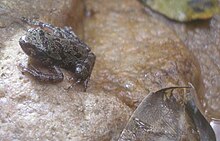| Eastern ghost frog | |
|---|---|

| |
| Conservation status | |
 Least Concern (IUCN 3.1) | |
| Scientific classification | |
| Domain: | Eukaryota |
| Kingdom: | Animalia |
| Phylum: | Chordata |
| Class: | Amphibia |
| Order: | Anura |
| Family: | Heleophrynidae |
| Genus: | Heleophryne |
| Species: | H. orientalis |
| Binomial name | |
| Heleophryne orientalis FitzSimons, 1946 | |
The eastern ghost frog (Heleophryne orientalis) is a species of frog in the family Heleophrynidae.
It is endemic to Western Cape Province, South Africa. Its natural habitats are forest patches surrounded by mountain fynbos heathland. Adult frogs live near slow- to swift-flowing perennial mountain streams in isolated canyons. They are typical sit-and-wait predators that hunt at night near to the splash zone of the mountain streams. Breeding takes place in fast-flowing, perennial streams. Clutches of 120–190 eggs are laid extra aquatic under moss-covered rocks. Like many frogs, their muscles and internal organs are visible due to their lower body being transparent. Distinguished within its taxonomic group, this species is well-known for its exceptional anatomical traits. Most prominently observed during the tadpole stage, their unique pigmentation sets them apart from other Heleophryinds, capturing attention and fascination among researchers and enthusiasts alike. Their tadpoles take two years to complete their development and possess unique larval features such as the appearance of both the mandibular and the rostral cartilage.
The eastern ghost frog is locally a common species that is not significantly threatened, but is locally impacted by introduced species.
References
- ^ IUCN SSC Amphibian Specialist Group (2013). "Heleophryne orientalis". IUCN Red List of Threatened Species. 2013: e.T55274A3026829. doi:10.2305/IUCN.UK.2013-2.RLTS.T55274A3026829.en. Retrieved 18 November 2021.
- Frost, Darrel R. (2014). "Heleophryne orientalis FitzSimons, 1946". Amphibian Species of the World: an Online Reference. Version 6.0. American Museum of Natural History. Retrieved 15 March 2014.
- Vitt, L. J. (2008). "Herpetology". Herpetology 3rd Edition. San Diego: Academic Press/ Elsevier.
- Halliday, T. (2016). "The Book of frogs: A life-sized guide to six hundred species from around the world". Brighton IVY Press.
- Lukas, Paul (October 2021). "Larval cranial anatomy of the Eastern Ghost Frog ( Heleophryne orientalis )". Acta Zoologica. 102 (4): 452–466. doi:10.1111/azo.12352. ISSN 0001-7272.
- Lukas, Paul (2020). "Larval cranial anatomy of the Eastern Ghost Frog (Heleophryne orientalis)". Acta Zoologica. 102 (4): 452–466. doi:10.1111/azo.12352.
| Taxon identifiers | |
|---|---|
| Heleophryne orientalis | |
 | This Neobatrachia-related article is a stub. You can help Misplaced Pages by expanding it. |